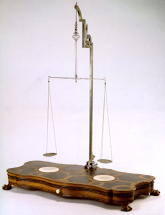
94 x 75 x 37
Black wood and saint-wood, iron,
brass and silver.
INDEX 1778: C.IV.101
Libra ocularis accuratissima, cum duabos lancibos argenteis. Hastae item ex orichalco duae cum Trochleis et stylobata elegantissimo, inserviens demonstrandis Librarum proprietatibus.
Ocular balance, very precise, with two silver pans. Equally, two brass spindles with pulleys and a very elegant stylobate; used to demonstrate the properties of the balances.
This is the first balance of the collection referred to in the Index as libra ocularis accuratissima. The meaning of accuratissima gives no cause for doubt. The meaning of ocularis, along with libra, would not be easily understood through dictionary meanings. The name refers to an opening existent on this type of balance, through which one can see when the end of the pointer stops at a fixed point, which is above it, and allows the observer to be sure of the state of equilibrium of the balance.
It is a very beautiful piece which owes its present appearance to the care of Professor Mário Silva who got it repaired. The elegant base is made of light-coloured wood inlaid with black wood, standing on four legs. At the centre of the lid, the initials R C are inscribed, but the significance of these initials is unknown. To the left and to the right of the initials are two white wooden circles made of satin-wood that correspond to the places where the plates of the balance sit. The balance is suspended from the top of the support which rises from the base. At the front of the base, in the centre, there is a small knob made of white wood which is connected in the interior to a cord that makes the balance go up. When this part is initially at a resting point the button is turned a little and pulled, this manoeuvre making the suspension of the balance ascend.
This lovely piece was made in Portugal, as the words inscribed on the beam of the balance suggest. On the front REAL FABRICA is inscribed, and on the back, SCHAPA PETRA. The H of the first of these names and the E of the second have a period (or dot) marked over them, which means that the H and the I of SCHIAPA, and the E and the I of PIETRA, fused into only one letter.
According to the Index, this balance was used to demonstrate the properties of those instruments. The subject is handled theoretically by dalla Bella in Physices Elementa (§ V to VII), saying that the qualities of a perfect balance are three: first, to be "mobilíssima", that is, to discriminate even the smallest weight placed in one of the pans; second, the two arms of the beam must be the same length and weight; third, the beam must be rigid, not deforming when the pans are loaded.
From Colégio dos Nobres, catalogue n.º 93.
Carvalho, Rómulo de, História do Gabinete de Física da Universidade de Coimbra, Universidade de Coimbra, Biblioteca Geral, Coimbra, 1978, pp. 241-242.